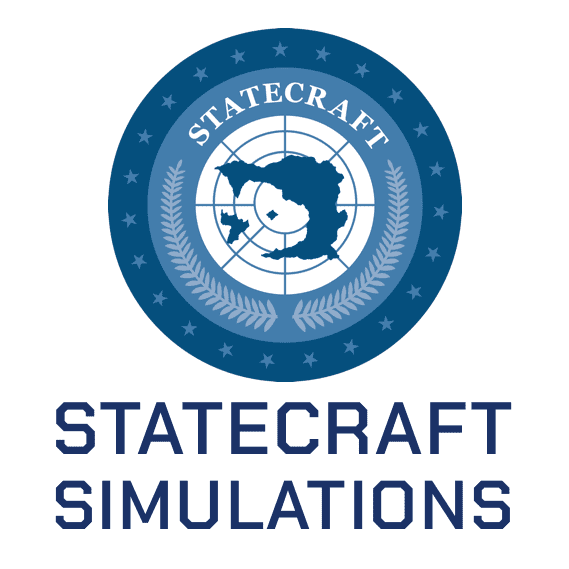International Organizations Simulation
Statecraft International Organizations offers an immersive, student-driven simulation that dynamically adapts based on student decisions, effectively illustrating dozens of key concepts including transparency, credible commitment, enforceability, human rights, the ICC, International Law, the WTO, the UN, proliferation, and nationalism vs. International Organizations. In this simulation, students take the helm of their own countries, determining their nation’s governmental structure, economic policies, and political systems while navigating through global challenges.Participants engage in critical decision-making for 7 to 10 weeks of the semester. This interactive platform not only enhances learning by providing a practical application of theoretical concepts but also significantly reduces instructors’ workload by an average of 13%.
Statecraft: International Organizations enhances learning by allowing students to apply the legal, political, and case study-focused content of “International Organizations Fourth Edition” by Ian Hurd through interactive scenarios, while offering practical insights into the structure and policies of major entities like the UN and EU as detailed in “International Organization” by Volker Rittberger and others. It also brings to life the principles and contemporary challenges discussed in “International Organizations: Principles and Issues (7th Edition)”, provides a platform for practical application of strategies from “How to Do Things With International Law” by Ian Hurd, and simulates the complex decision-making processes within the UN Security Council explored in “After Anarchy: Legitimacy and Power in the UN Security Council” also by Ian Hurd.
Length of Simulation & Class Time
The International Organizations Simulation runs for a default 7 to 10 weeks with each week being considered a “turn” (many instructors choose to run the sim for 12 or even 15 weeks, this is completely up to you and no extra charge to extend your simulation).
Note: A rule of thumb when scheduling turns is that each one requires about 1.5 to 3 hours of work from the students.
Turn 0 is a Tutorial week for students to establish a basic understanding of the simulation and set up their countries. The sim runs live 24/7 which allows for maximum convenience for both instructors and students to cut deals and make decisions on their own time. We recommend establishing a 7 day per Turn schedule and having at least one day per week where you encourage students to negotiate, hold international negotiations, and even make speeches defending their countries’ actions on various global issues.
Note: We recommend not telling your class how many Turns the simulation will last as students can act unrealistically and unpredictably when they know they are on the final turn.
Alternative Schedule Formats
Tapered turn schedules: If you want to run the full simulation within 4 weeks you can use the tapered turn schedule model by decreasing the length of each turn by one day until you have just two days per turn. It is recommended to contact support at [email protected] for assistance and guidance on this setup. This great for summer, winter, or shorteneded semesters!
One day sim: If you want to run the simulation in one day you only need 30 minutes between turns. In a format like this you would schedule an all day play through with students on a saturday or sunday from 8 AM to 5 PM with a lunch break. It is recommended to contact support at [email protected] for assistance and guidance on this setup
What Happens During a Turn
The simulation automatically groups students into countries based on the Foreign Policy Attitude Survey they take during the signup process. During Turn 0 students vote for their President, name their country and cities, and choose their government type and attributes.
Every week students are given a checklist and walkthroughs of their screen to guide them in achieving their goals and interacting with other countries. At the beginning of each Turn, students receive news messages with updates on major events and situations unfolding in their simulation. Instructors can also find these under “News” on the top of the instructor dashboard.
From here they will start making decisions about trade, country development, domestic politics, economics, the environment, and national security. All of their choices are cancellable until the turn ends. Once the turn ends the simulation will calculate the impact of all student choices and start the next turn with new world conditions and unfolding sim events.
Suggested Base Knowledge of Students
No base knowledge is required, however, to maximize the learning experience for students, we recommend the simulation start after covering the basics of the course for at least a few weeks. Since the sim normally runs for 7-10 weeks, earlier course concepts may help in cementing actions within the sim.
Class Assignments
Many instructors get creative with how they connect classroom assignments to the simulation. These may be a good fit for your class:
- Memos: Instructors can provide students with a list of memo prompts that help students tie their simulation experience to course topics.
- Debrief Presentation: This is a guided debrief that helps students reflect on the key moments that unfolded throughout the simulation. This allows them to “reveal their cards” and openly explain their perspectives and actions from a 360 degree perspective.
- Debrief Paper Assignments: A paper to go along with the Debriefing Presentation that goes more in depth on how the debrief topic unfolded during the simulation.
Student Engagement Tracking
To keep track of students decisions, there are multiple tools for instructors to utilize:
- The toggle option at top left of the map gives instructors a visual display of countries’ international attitudes and actions involving trade, diplomacy, conflict, and country development. The map is populated with country development rings surrounding capital cities along with colored arrows that indicate an array of collaborative and aggressive actions. Instructors can click on them to “drill down” for specific details about each action and country interaction.
- Weekly emails go straight to the instructor inbox and give an overview of sim events, country attitudes and general actions, and a students’ engagement report.
- Reading at least one memo from each country during each week can be a great way to understand how students perceive what is happening and how they currently feel about other countries and simulation events. You can even change the memo topic for each week based on the things you would like to better understand from the student perspective
- Instructors can also log into each students’ dashboard and read their messages to see which peers a student may be interacting with.
Grading
The following grading criteria is a basic recommendation and can be customized to fit your classroom needs.
- 5% – Simulation Performance: Students’ simulation performance score is based on the accumulation of points through the achievement of collective goals, competitive goals, and the best average Quality of Life scores.
- 10% – Simulation Participation: Students are prompted to take two Manual quizzes during Turn 0 and Turn 1 which can be used as part of the participation grade. Students can connect the course materials more meaningfully to their class by writing weekly memos. Students are also prompted to rate the level of influence of exceptional peers in the simulation. You can add this Sim Participation, Sim Performance, or consider giving it as extra credit for anyone who receives it.
- 15% to 30% – Paper or Debriefing Presentation: The paper or debriefing presentation requires you to integrate your simulation experience with a variety of course concepts.
- 10% – 25% – Debriefing Paper – a paper that accompanies the debriefing presentation over the same topic. Students turn in their paper after they debrief the class on their chosen topic.
Textbook Examples to go with International Organization Simulation
“International Organizations Fourth Edition” by Ian Hurd:
- Case Study Application: The textbook uses chapter-length case studies to explore the workings of international organizations. Statecraft Simulations can provide students with live, interactive scenarios that mimic these case studies, allowing them to experiment with the concepts and dynamics discussed in the book.
- Legal and Political Aspects: As students navigate through the simulation, they encounter situations that require understanding and applying international law and political strategies, directly reflecting the book’s focus on legal and political aspects of international organizations.
“International Organization” by Volker Rittberger, et al.:
- Structure and Internal Workings: This book delves into the structure and policies of organizations like the UN, EU, IMF, and World Bank. In Statecraft Simulations, students can role-play as representatives of similar entities, gaining insights into the internal and external pressures these organizations face.
- Policy Implementation and Effects: Simulations allow students to make policy decisions and see their effects in real time, which helps in understanding the complexities of policy-making and implementation in international organizations.
“International Organizations: Principles and Issues (7th Edition)”:
- Principles of Operation: The simulation settings can be designed to highlight the principles discussed in the textbook, such as sovereignty, the role of states, and the impact of non-state actors, giving students a firsthand experience of these concepts.
- Current Issues and Challenges: Students can engage in scenarios that reflect current global challenges, which helps in applying the textbook’s discussions on contemporary issues in a practical context.
“How to Do Things With International Law” by Ian Hurd:
- Application of International Law: This book provides insights into the practical uses of international law. Through simulations, students can apply legal principles in diplomatic negotiations or conflict resolutions, mirroring the book’s approach to international law as an active tool.
“After Anarchy: Legitimacy and Power in the UN Security Council” by Ian Hurd:
- UN Security Council Dynamics: The simulations can include scenarios that simulate the decision-making process within the UN Security Council, allowing students to explore the concepts of legitimacy and power dynamics that are critical to the council’s function.
- Strategic Decision-Making: By engaging in simulations that mimic Security Council operations, students can practice the strategic and ethical decision-making that is necessary for maintaining international peace and security.
Statecraft: International Organizations enhances learning by allowing students to apply the legal, political, and case study-focused content of “International Organizations Fourth Edition” by Ian Hurd through interactive scenarios, while offering practical insights into the structure and policies of major entities like the UN and EU as detailed in “International Organization” by Volker Rittberger and others. It also brings to life the principles and contemporary challenges discussed in “International Organizations: Principles and Issues (7th Edition)”, provides a platform for practical application of strategies from “How to Do Things With International Law” by Ian Hurd, and simulates the complex decision-making processes within the UN Security Council explored in “After Anarchy: Legitimacy and Power in the UN Security Council” also by Ian Hurd.
Statecraft Simulations are used in 15 countries at over 475 universities
Elevate Your International Relations Studies with Statecraft's International Organizations Simulation: A Practical Companion to Leading Textbooks like Ian Hurd's and Volker Rittberger's Works
“International Organizations Fourth Edition” by Ian Hurd:
- Case Study Application: The textbook uses chapter-length case studies to explore the workings of international organizations. Statecraft Simulations can provide students with live, interactive scenarios that mimic these case studies, allowing them to experiment with the concepts and dynamics discussed in the book.
- Legal and Political Aspects: As students navigate through the simulation, they encounter situations that require understanding and applying international law and political strategies, directly reflecting the book’s focus on legal and political aspects of international organizations.
“International Organization” by Volker Rittberger, et al.:
- Structure and Internal Workings: This book delves into the structure and policies of organizations like the UN, EU, IMF, and World Bank. In Statecraft Simulations, students can role-play as representatives of similar entities, gaining insights into the internal and external pressures these organizations face.
- Policy Implementation and Effects: Simulations allow students to make policy decisions and see their effects in real time, which helps in understanding the complexities of policy-making and implementation in international organizations.
“International Organizations: Principles and Issues (7th Edition)”:
- Principles of Operation: The simulation settings can be designed to highlight the principles discussed in the textbook, such as sovereignty, the role of states, and the impact of non-state actors, giving students a firsthand experience of these concepts.
- Current Issues and Challenges: Students can engage in scenarios that reflect current global challenges, which helps in applying the textbook’s discussions on contemporary issues in a practical context.
“How to Do Things With International Law” by Ian Hurd:
- Application of International Law: This book provides insights into the practical uses of international law. Through simulations, students can apply legal principles in diplomatic negotiations or conflict resolutions, mirroring the book’s approach to international law as an active tool.
“After Anarchy: Legitimacy and Power in the UN Security Council” by Ian Hurd:
- UN Security Council Dynamics: The simulations can include scenarios that simulate the decision-making process within the UN Security Council, allowing students to explore the concepts of legitimacy and power dynamics that are critical to the council’s function.
- Strategic Decision-Making: By engaging in simulations that mimic Security Council operations, students can practice the strategic and ethical decision-making that is necessary for maintaining international peace and security.
Strategy
To gather points students can pursue a myriad of strategies: from avoiding conflict for domestic wellbeing to cautiously collaborative strategies that maximize economic synergies while carefully checking other countries' imperial motives. It is possible that every country could get a perfect score and all thrive; however (just like in the real world) that rarely happens.
Goals
Each turn students try to achieve three types of goals: (1) Cooperative Global Goals that are shared with the entire world such as ending world hunger; (2) Competitive Country Goals for excelling in a certain area such as “Most Environmentally Friendly” or “Safest” and finally (3) Country Development Goals based on domestic factors such as citizens' health, welfare, environment, safety and education. (4) Secret Goals only their country knows about which may cause them to act in ways that create challenges to collaborate and build international consensus.
Domestic Factors
Every turn countries will produce resources students must decide how to invest; they’ll bump up against the classic “guns vs. butter” conundrum. They’ll also get a Quality of Life score that equates to points for their citizens' health, welfare, environment, safety and education. Unhappy citizens riot! Unhealthy citizens die of famine!
International Factors
There are pirates terrorizing the world! Ice Mountain is melting and threatening to flood the entire globe! Should they participate in the U.N.? Can students come to an agreement on nuclear missiles and technology? Can the IAEA actually enforce the treaty? Both simulation events and classmates create drama and excitement and demonstrate how intertwined a world truly is.
Statecraft: International Organizations enhances learning by allowing students to apply the legal, political, and case study-focused content of “International Organizations Fourth Edition” by Ian Hurd through interactive scenarios, while offering practical insights into the structure and policies of major entities like the UN and EU as detailed in “International Organization” by Volker Rittberger and others. It also brings to life the principles and contemporary challenges discussed in “International Organizations: Principles and Issues (7th Edition)”, provides a platform for practical application of strategies from “How to Do Things With International Law” by Ian Hurd, and simulates the complex decision-making processes within the UN Security Council explored in “After Anarchy: Legitimacy and Power in the UN Security Council” also by Ian Hurd.
Student map interface
The Statecraft World Map is where all of the action happens! Students can log in via a desktop computer or a mobile device. The map illustrates the geographical layout of the world showing resource centers, deserts and mountains as well as the climate situation. The colored lines delineate territory zones belonging to each country. The icons mark cities, military units, landmarks and terrorist occupations. Once a student spies on a foreign country those cities and military units will also be exposed. Clicking on the icons reveals more information and there’s a detailed legend key to offer extra map guidance.
In the nav bars at the top students can access all of the critical information for their world as well as look at their intelligence data for other countries. They’ll be able to access their Diplomacy, Military, Intelligence, Domestic and Research activities as well as manage their Resources.
Diplomacy
- Build International Organizations
- Collaborate to solve global issues like climate change, world hunger, terrorism, and human rights
- Construct Treaties
- Exchange Ambassadors
International Organizations & Military
- Establish Negotiation Rules
- Collaborate to identify the needs of other countries and how to come to an agreement
- Sign an international treaty and try to gain consensus
- Try to maintain and enforce the treaty you agree to
Intelligence
- Spy on other countries' domestic politics, economy, and military capabilities
- Build counter-intelligence capabilities to limit spying in their own country
- Run covert operations to sabotage and undermine other countries
- Strategically build their national defense strategy
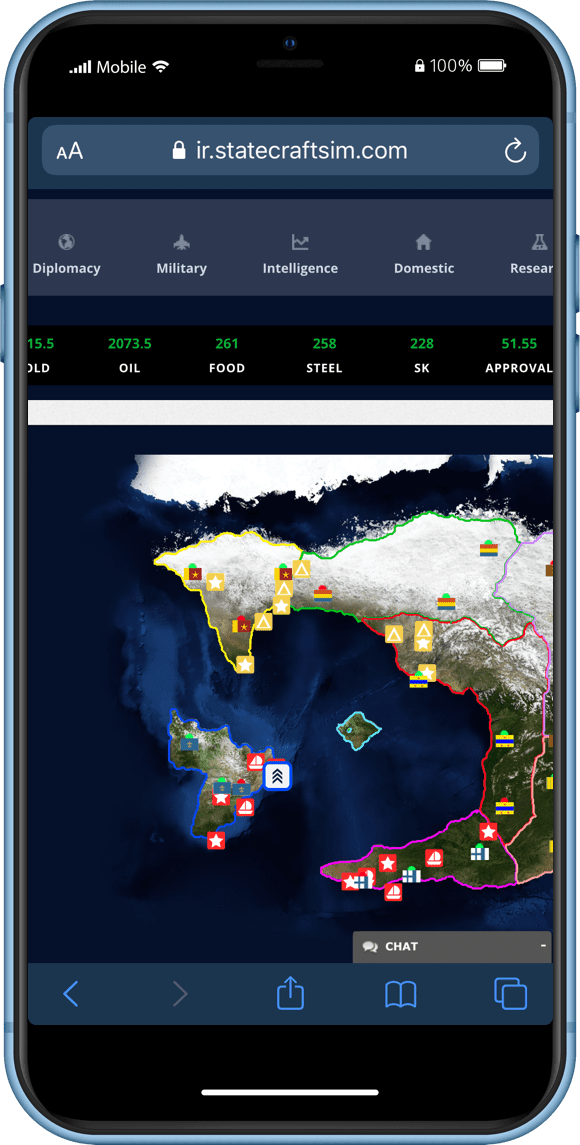
Domestic
- Enhance your Citizens' Healthcare and Unemployment System
- Improve your Justice System and Environment
- Invest in Public Education and University Systems
- Foster your country’s unique culture and gain tourism points!
Research
- Gain new, powerful technologies that can enhance domestic ratings such as health, safety, the environment, or improve national security
- Trade technologies with other countries to more rapidly develop their Quality of Life and National security
Resources Bar
- Manage economic resources
- Budget for enhancing domestic infrastructure or security
- Trade with other countries and develop relationships with countries that produce needed resources
Statecraft: International Organizations enhances learning by allowing students to apply the legal, political, and case study-focused content of “International Organizations Fourth Edition” by Ian Hurd through interactive scenarios, while offering practical insights into the structure and policies of major entities like the UN and EU as detailed in “International Organization” by Volker Rittberger and others. It also brings to life the principles and contemporary challenges discussed in “International Organizations: Principles and Issues (7th Edition)”, provides a platform for practical application of strategies from “How to Do Things With International Law” by Ian Hurd, and simulates the complex decision-making processes within the UN Security Council explored in “After Anarchy: Legitimacy and Power in the UN Security Council” also by Ian Hurd.
how it works
Easy Set-up & Launch
- Easily adaptable for small classes under 20 students or for large classes up to 600 students running multiple worlds; each world will have six to 108 students
- Run through an easy 3-minute configuration and get the code for students to activate their simulation
- When students sign up with the code they’ll pay for the simulation
- The Foreign Policy Attitude Survey automatically groups like-minded students together into countries when they sign up, ensuring variation in countries’ views and policy approaches
- You set the start date plus the number and duration of the “turns”; commonly teachers launch the simulation in the third week of the semester and run it for seven to 10 turns/weeks, however you have complete control to set the optimal timing based on your class needs and schedule
- There will be six to 12 countries in each world with up to nine roles per country
- Students receive a comprehensive instruction manual and their first quiz asks key questions from the manual to make sure they understand how to play
- During the preparatory “Turn Zero” students configure their country and personal roles
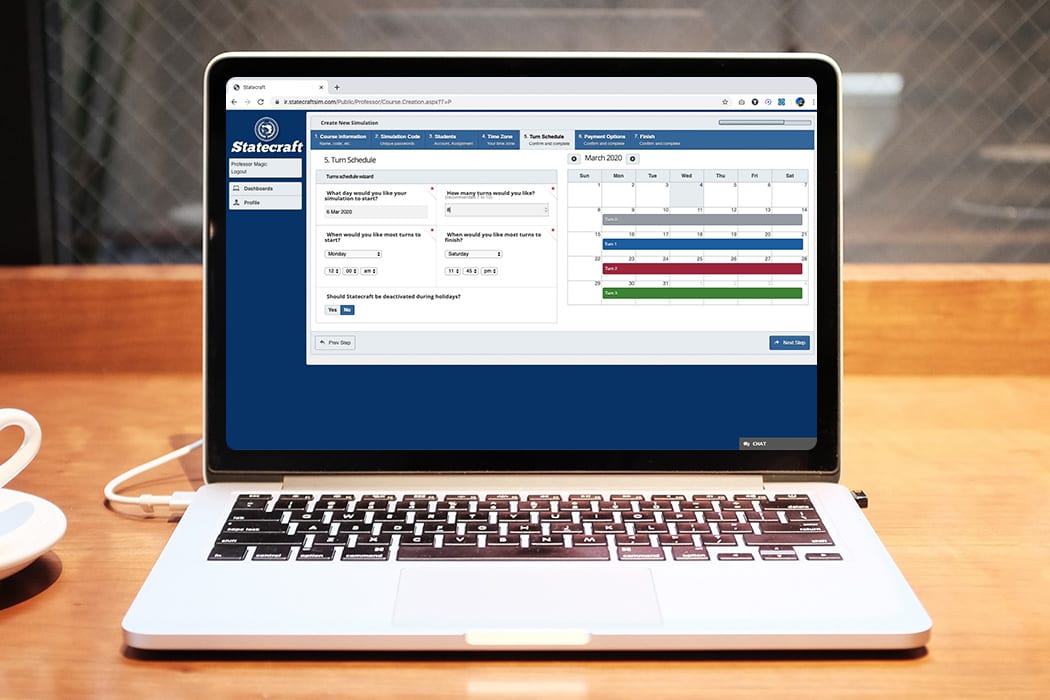

Playing the Simulation
- Students are playing to earn points by achieving both the world collective goals and their individual country goals
- Everything is prompted by the system; it tallies points for performance and participation and calculates grades for you at the end of the simulation
- The simulation runs live 24-7 so students can play anytime without you needing to schedule class time or a computer lab
- At the end of each turn the decisions or “moves” students made during the turn actually happen and they can see the results of their actions
- Every turn each country produces resources that can be used to buy military units and domestic structures, trade with other countries, research technology and invest in big projects like Alcatraz or the Louvre
- Students also make strategic decisions such as drafting treaties, forming alliances, engaging in espionage or launching a military attack
- Global issues such as terrorism and climate change will affect all of the countries in the world, requiring collaboration to resolve
The Instructor's Role
- Watch as the students collaborate and compete with one another to be successful and gain the most points
- Act as an executive consultant to help guide students and answer questions about how real-world countries deal with similar challenges through diplomacy, international organizations, economic statecraft, and military action
- Statecraft help desk will assist students with any technical questions or troubleshooting
- Use the simulation events as learning opportunities to draw correlations to course concepts
- See all of the events happening in the simulation by looking at the global map and tracking tools
- Offer students 30+ minutes of in-class time to meet each week to decide on big world moves face-to-face; these classes are often dramatic and fun! (recommended but not required)
- If needed you can use a master account to make “godlike” decisions should there be world crisis; as the instructor you always have ultimate control over your simulation world

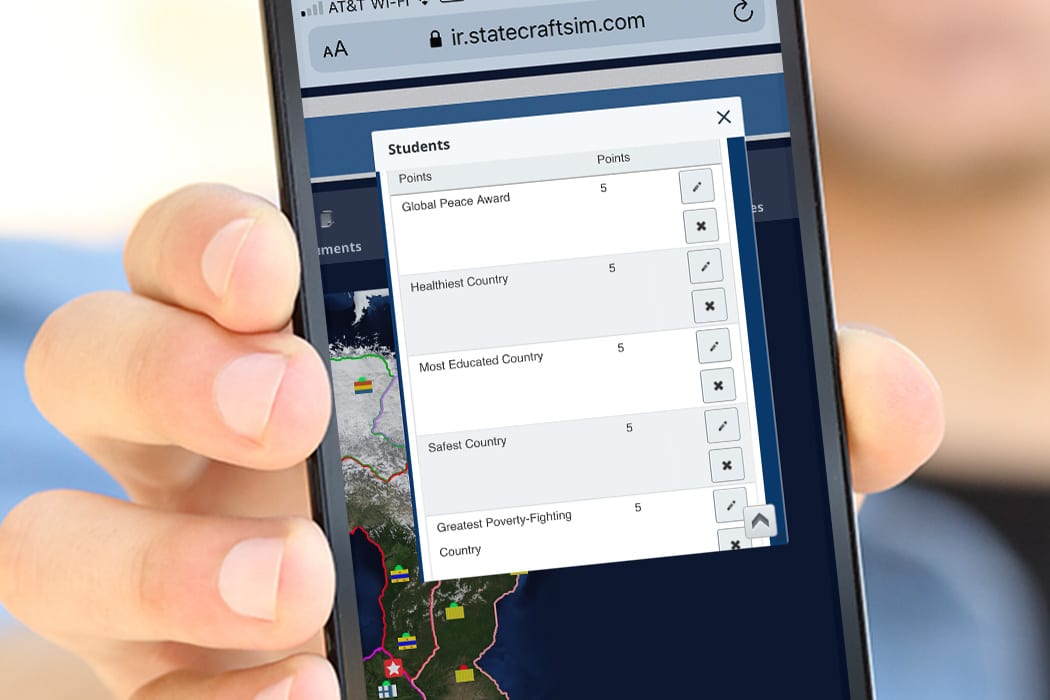
Conclusion & Grading
- When the last turn ends global goal points are given, individual country points are tallied, awards are bestowed and grades are issued
- The system provides a gradebook showing students’ final point totals in a table that is easily exportable to Excel
- Statecraft also offers suggested assignments (quiz/exam questions, paper topics, and discussion questions) that can count toward students’ course grades
- We recommend a final debrief in which countries present their version of “what happened” so the class and the instructor have insight into all perspectives
- Students can still receive a good grade for participating fully in the simulation even if their country and world collapse due to poor choices (but instructors can modify grades based on apparent effort)
- There are unlimited outcomes possible for the simulation! Every run of the Statecraft IR Simulation result is unique
- Since every class experience is unique, it is difficult for students to “cheat” by relying on outside help or past students’ experiences; In this way, the simulation encourages academic honesty and makes assessments easier for you
If you’re looking for even more detailed information, see the Resources page for the instructor manual, sample syllabus and other helpful documentation.
Statecraft: International Organizations enhances learning by allowing students to apply the legal, political, and case study-focused content of “International Organizations Fourth Edition” by Ian Hurd through interactive scenarios, while offering practical insights into the structure and policies of major entities like the UN and EU as detailed in “International Organization” by Volker Rittberger and others. It also brings to life the principles and contemporary challenges discussed in “International Organizations: Principles and Issues (7th Edition)”, provides a platform for practical application of strategies from “How to Do Things With International Law” by Ian Hurd, and simulates the complex decision-making processes within the UN Security Council explored in “After Anarchy: Legitimacy and Power in the UN Security Council” also by Ian Hurd.
Let's do this! Experience Statecraft for Yourself
Book your personal demo today! We’ll answer your questions, show you how these cool features work and help you set up your first Statecraft IO Simulation.
Course concepts covered
Statecraft Simulations allows students to apply the legal, political, and practical insights from “International Organizations Fourth Edition” by Ian Hurd through interactive scenarios, while exploring the structure and policies of entities like the UN as detailed in “International Organization” by Volker Rittberger and others. It also brings the principles and challenges from “International Organizations: Principles and Issues (7th Edition)” to life, applies strategies from “How to Do Things With International Law” by Ian Hurd, and simulates decision-making in the UN Security Council as discussed in “After Anarchy: Legitimacy and Power in the UN Security Council” by Ian Hurd.
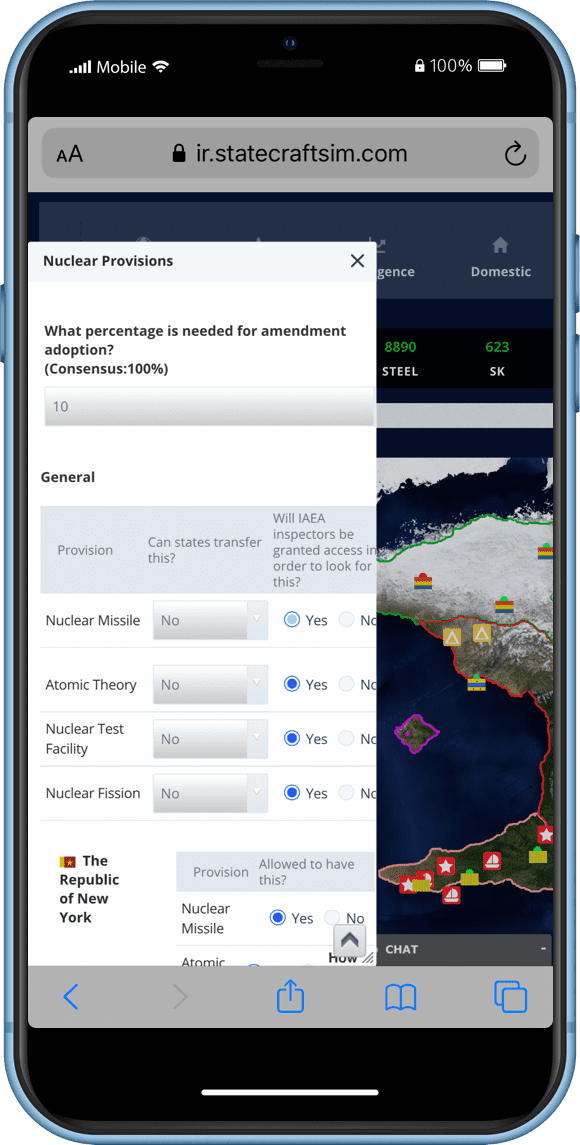
International Non-Governmental Organizations
Two Level Games
International Governmental Organizations
Feminist Theory
Human Rights
Marxism
International Law/Norms
Globalization
The Politics of the Global Environment
Interdependence
Development Disparity
Reasons the Statecraft IO Simulation is so effective:
- An innovative way to teach concepts beyond traditional lectures
- Concepts become personal and experienced by students
- Students are engaged and participating both inside and outside of class
- Engagement enhances the knowledge acquisition process
- Students take ownership of their experience and are empowered to shine
- In order to succeed, students must apply course knowledge and do context-based problem solving
- Teaches career skills like leadership, teamwork, negotiation and strategic thinking that help them become more employable
- Students must apply course knowledge and do context-based problem solving to succeed
- Working in teams on common goals fosters student collaboration and relationship building even in large lecture classes


Results you’ll experience:
- Heightened student engagement & greater attendance
- Quality student questions and requests for strategy consultation
- Students are able to discuss course concepts intelligently and develop strong opinions that spark interesting class conversations
- More camaraderie among the students, social connections, sense of community
- Students will form study groups and you’ll hear students speaking about topics topics such as enforcing UN resolutions or the security dilemma outside the classroom
- Statecraft Simulations promote academic honesty: since every simulation experience is completely unique it’s practically impossible for students to cheat
- Your class popularity will increase due to previous student recommendations
Statecraft: International Organizations enhances learning by allowing students to apply the legal, political, and case study-focused content of “International Organizations Fourth Edition” by Ian Hurd through interactive scenarios, while offering practical insights into the structure and policies of major entities like the UN and EU as detailed in “International Organization” by Volker Rittberger and others. It also brings to life the principles and contemporary challenges discussed in “International Organizations: Principles and Issues (7th Edition)”, provides a platform for practical application of strategies from “How to Do Things With International Law” by Ian Hurd, and simulates the complex decision-making processes within the UN Security Council explored in “After Anarchy: Legitimacy and Power in the UN Security Council” also by Ian Hurd.
Costs much less than a textbook
Students pay
$39.75
- One-time payment per student per semester
- You assign the simulation to students, give them the activation code and they purchase it just like they would purchase a textbook
- Statecraft cares deeply about facilitating student learning so we keep pricing as accessible as possible
"Students benefit greatly from playing"

Statecraft: International Organizations enhances learning by allowing students to apply the legal, political, and case study-focused content of “International Organizations Fourth Edition” by Ian Hurd through interactive scenarios, while offering practical insights into the structure and policies of major entities like the UN and EU as detailed in “International Organization” by Volker Rittberger and others. It also brings to life the principles and contemporary challenges discussed in “International Organizations: Principles and Issues (7th Edition)”, provides a platform for practical application of strategies from “How to Do Things With International Law” by Ian Hurd, and simulates the complex decision-making processes within the UN Security Council explored in “After Anarchy: Legitimacy and Power in the UN Security Council” also by Ian Hurd.
Get started today to experience how Statecraft brings International Organizations to life in your course!
You can sign up online now to get started immediately or book your personal demo! We’ll give you a complete product tour, answer all of your questions and help you configure your first Statecraft IO Simulation.
Statecraft Simulations are used in 15 countries at over 475 universities
Let's Keep In Touch
Sign up for the Statecraft Newsletter and we’ll send you product updates, simulation tips and exclusive offers straight to your inbox!
Statecraft: International Organizations enhances learning by allowing students to apply the legal, political, and case study-focused content of “International Organizations Fourth Edition” by Ian Hurd through interactive scenarios, while offering practical insights into the structure and policies of major entities like the UN and EU as detailed in “International Organization” by Volker Rittberger and others. It also brings to life the principles and contemporary challenges discussed in “International Organizations: Principles and Issues (7th Edition)”, provides a platform for practical application of strategies from “How to Do Things With International Law” by Ian Hurd, and simulates the complex decision-making processes within the UN Security Council explored in “After Anarchy: Legitimacy and Power in the UN Security Council” also by Ian Hurd.
Elevate Your International Relations Studies with Statecraft's International Organizations Simulation: A Practical Companion to Leading Textbooks like Ian Hurd's and Volker Rittberger's Works
“International Organizations Fourth Edition” by Ian Hurd:
- Case Study Application: The textbook uses chapter-length case studies to explore the workings of international organizations. Statecraft Simulations can provide students with live, interactive scenarios that mimic these case studies, allowing them to experiment with the concepts and dynamics discussed in the book.
- Legal and Political Aspects: As students navigate through the simulation, they encounter situations that require understanding and applying international law and political strategies, directly reflecting the book’s focus on legal and political aspects of international organizations.
“International Organization” by Volker Rittberger, et al.:
- Structure and Internal Workings: This book delves into the structure and policies of organizations like the UN, EU, IMF, and World Bank. In Statecraft Simulations, students can role-play as representatives of similar entities, gaining insights into the internal and external pressures these organizations face.
- Policy Implementation and Effects: Simulations allow students to make policy decisions and see their effects in real time, which helps in understanding the complexities of policy-making and implementation in international organizations.
“International Organizations: Principles and Issues (7th Edition)”:
- Principles of Operation: The simulation settings can be designed to highlight the principles discussed in the textbook, such as sovereignty, the role of states, and the impact of non-state actors, giving students a firsthand experience of these concepts.
- Current Issues and Challenges: Students can engage in scenarios that reflect current global challenges, which helps in applying the textbook’s discussions on contemporary issues in a practical context.
“How to Do Things With International Law” by Ian Hurd:
- Application of International Law: This book provides insights into the practical uses of international law. Through simulations, students can apply legal principles in diplomatic negotiations or conflict resolutions, mirroring the book’s approach to international law as an active tool.
“After Anarchy: Legitimacy and Power in the UN Security Council” by Ian Hurd:
- UN Security Council Dynamics: The simulations can include scenarios that simulate the decision-making process within the UN Security Council, allowing students to explore the concepts of legitimacy and power dynamics that are critical to the council’s function.
- Strategic Decision-Making: By engaging in simulations that mimic Security Council operations, students can practice the strategic and ethical decision-making that is necessary for maintaining international peace and security.
Elevate Your International Relations Studies with Statecraft's International Organizations Simulation: A Practical Companion to Leading Textbooks like Ian Hurd's and Volker Rittberger's Works
“International Organizations Fourth Edition” by Ian Hurd:
- Case Study Application: The textbook uses chapter-length case studies to explore the workings of international organizations. Statecraft Simulations can provide students with live, interactive scenarios that mimic these case studies, allowing them to experiment with the concepts and dynamics discussed in the book.
- Legal and Political Aspects: As students navigate through the simulation, they encounter situations that require understanding and applying international law and political strategies, directly reflecting the book’s focus on legal and political aspects of international organizations.
“International Organization” by Volker Rittberger, et al.:
- Structure and Internal Workings: This book delves into the structure and policies of organizations like the UN, EU, IMF, and World Bank. In Statecraft Simulations, students can role-play as representatives of similar entities, gaining insights into the internal and external pressures these organizations face.
- Policy Implementation and Effects: Simulations allow students to make policy decisions and see their effects in real time, which helps in understanding the complexities of policy-making and implementation in international organizations.
“International Organizations: Principles and Issues (7th Edition)”:
- Principles of Operation: The simulation settings can be designed to highlight the principles discussed in the textbook, such as sovereignty, the role of states, and the impact of non-state actors, giving students a firsthand experience of these concepts.
- Current Issues and Challenges: Students can engage in scenarios that reflect current global challenges, which helps in applying the textbook’s discussions on contemporary issues in a practical context.
“How to Do Things With International Law” by Ian Hurd:
- Application of International Law: This book provides insights into the practical uses of international law. Through simulations, students can apply legal principles in diplomatic negotiations or conflict resolutions, mirroring the book’s approach to international law as an active tool.
“After Anarchy: Legitimacy and Power in the UN Security Council” by Ian Hurd:
- UN Security Council Dynamics: The simulations can include scenarios that simulate the decision-making process within the UN Security Council, allowing students to explore the concepts of legitimacy and power dynamics that are critical to the council’s function.
- Strategic Decision-Making: By engaging in simulations that mimic Security Council operations, students can practice the strategic and ethical decision-making that is necessary for maintaining international peace and security.
Elevate Your International Relations Studies with Statecraft's International Organizations Simulation: A Practical Companion to Leading Textbooks like Ian Hurd's and Volker Rittberger's Works
“International Organizations Fourth Edition” by Ian Hurd:
- Case Study Application: The textbook uses chapter-length case studies to explore the workings of international organizations. Statecraft Simulations can provide students with live, interactive scenarios that mimic these case studies, allowing them to experiment with the concepts and dynamics discussed in the book.
- Legal and Political Aspects: As students navigate through the simulation, they encounter situations that require understanding and applying international law and political strategies, directly reflecting the book’s focus on legal and political aspects of international organizations.
“International Organization” by Volker Rittberger, et al.:
- Structure and Internal Workings: This book delves into the structure and policies of organizations like the UN, EU, IMF, and World Bank. In Statecraft Simulations, students can role-play as representatives of similar entities, gaining insights into the internal and external pressures these organizations face.
- Policy Implementation and Effects: Simulations allow students to make policy decisions and see their effects in real time, which helps in understanding the complexities of policy-making and implementation in international organizations.
“International Organizations: Principles and Issues (7th Edition)”:
- Principles of Operation: The simulation settings can be designed to highlight the principles discussed in the textbook, such as sovereignty, the role of states, and the impact of non-state actors, giving students a firsthand experience of these concepts.
- Current Issues and Challenges: Students can engage in scenarios that reflect current global challenges, which helps in applying the textbook’s discussions on contemporary issues in a practical context.
“How to Do Things With International Law” by Ian Hurd:
- Application of International Law: This book provides insights into the practical uses of international law. Through simulations, students can apply legal principles in diplomatic negotiations or conflict resolutions, mirroring the book’s approach to international law as an active tool.
“After Anarchy: Legitimacy and Power in the UN Security Council” by Ian Hurd:
- UN Security Council Dynamics: The simulations can include scenarios that simulate the decision-making process within the UN Security Council, allowing students to explore the concepts of legitimacy and power dynamics that are critical to the council’s function.
- Strategic Decision-Making: By engaging in simulations that mimic Security Council operations, students can practice the strategic and ethical decision-making that is necessary for maintaining international peace and security.
